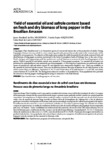Por favor, use este identificador para citar o enlazar este ítem:
http://www.alice.cnptia.embrapa.br/alice/handle/doc/1013647Registro completo de metadatos
| Campo DC | Valor | Lengua/Idioma |
|---|---|---|
| dc.contributor.author | NEGREIROS, J. R. da S. | pt_BR |
| dc.contributor.author | MIQUELONI, D. P. | pt_BR |
| dc.contributor.author | CARTAXO, C. B. da C. | pt_BR |
| dc.date.accessioned | 2015-04-15T11:11:11Z | pt_BR |
| dc.date.available | 2015-04-15T11:11:11Z | pt_BR |
| dc.date.created | 2015-04-15 | pt_BR |
| dc.date.issued | 2015 | pt_BR |
| dc.identifier.citation | Acta Amazonica, Manaus, v. 45, n.1, p. 75-80, 2015. | pt_BR |
| dc.identifier.issn | 0044-5967 | pt_BR |
| dc.identifier.uri | http://www.alice.cnptia.embrapa.br/alice/handle/doc/1013647 | pt_BR |
| dc.description | Long pepper (Piper hispidinervum) is an Amazonian species of commercial interest due to the production of safrole. Drying long pepper biomass to extract safrole is a time consuming and costly process that can also result in the contamination of the material by microorganisms. The objective of this study was to analyze the yield of essential oil and safrole content of fresh and dried biomass of long pepper accessions maintained in the Active Germoplasm Bank of Embrapa Acre, in the state of Acre, Brazil, aiming at selecting genotypes with best performance on fresh biomass to recommend to the breeding program of the species. Yield of essential oil and safrole content were assessed in 15 long pepper accessions. The essential oil extraction was performed by hydrodistillation and analyzed by gas chromatography. A joint analysis of experiments was performed and the means of essential oil yield and safrole content for each biomass were compared by Student's t-test. There was variability in the essential oil yield and safrole content. There was no difference between the types of biomass for oil yield; however to the safrole content there was difference. Populations 9, 10, 12 and 15 had values of oil yield between 4.1 and 5.3%, and safrole content between 87.2 and 94.3%. The drying process does not interfere in oil productivity. These populations have potential for selection to the long pepper breeding program using oil extraction in the fresh biomass. | pt_BR |
| dc.language.iso | eng | eng |
| dc.rights | openAccess | eng |
| dc.subject | Safrol | pt_BR |
| dc.subject | Biomasa | pt_BR |
| dc.subject | Aceites esenciales | pt_BR |
| dc.subject | Acumulación de materia seca | pt_BR |
| dc.subject | Rendimiento de los cultivos | pt_BR |
| dc.title | Yield of essential oil and safrole content based on fresh and dry biomass of long pepper in the Brazilian Amazon. | pt_BR |
| dc.type | Artigo de periódico | pt_BR |
| dc.date.updated | 2017-06-21T11:11:11Z | pt_BR |
| dc.subject.thesagro | Pimenta longa | pt_BR |
| dc.subject.thesagro | Piper hispidinervum | pt_BR |
| dc.subject.thesagro | Óleo essencial | pt_BR |
| dc.subject.thesagro | Rendimento | pt_BR |
| dc.subject.thesagro | Biomassa | pt_BR |
| dc.subject.thesagro | Matéria seca | pt_BR |
| dc.subject.nalthesaurus | Piper longum | pt_BR |
| dc.subject.nalthesaurus | Essential oils | pt_BR |
| dc.subject.nalthesaurus | Safrole | pt_BR |
| dc.subject.nalthesaurus | Crop yield | pt_BR |
| dc.subject.nalthesaurus | Biomass | pt_BR |
| dc.subject.nalthesaurus | Dry matter accumulation | pt_BR |
| riaa.ainfo.id | 1013647 | pt_BR |
| riaa.ainfo.lastupdate | 2017-06-21 | pt_BR |
| dc.identifier.doi | http://dx.doi.org/10.1590/1809-4392201400794 | pt_BR |
| dc.contributor.institution | JACSON RONDINELLI DA S NEGREIROS, CPAF-AC; Daniela Popim Moqueloni, Universidade Federal do Acre (Ufac); CLEISA BRASIL DA CUNHA CARTAXO, CPAF-AC. | pt_BR |
| Aparece en las colecciones: | Artigo em periódico indexado (CPAF-AC)  | |
Ficheros en este ítem:
| Fichero | Descripción | Tamaño | Formato | |
|---|---|---|---|---|
| 25458.pdf | 151.88 kB | Adobe PDF |  Visualizar/Abrir |









